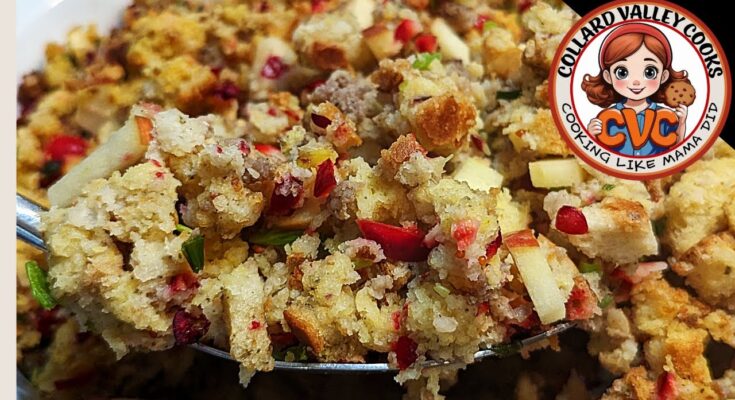Sausage Dressing Recipe: Sausage dressing is one of those comfort foods that instantly transports you to a warm, festive table surrounded by family and friends. Often confused with stuffing, dressing is technically the same dish but baked outside the bird. While stuffing goes inside the turkey, dressing is baked on its own—making it safer, crispier, and just as flavorful.
This beloved dish combines cubed bread, rich savory sausage, sautéed vegetables, and aromatic herbs. It’s a staple at Thanksgiving, Christmas, and other special dinners because it checks all the boxes: warm, hearty, flavorful, and perfect for feeding a crowd. And the best part? It’s totally customizable. Whether you like it herbaceous, spicy, loaded with veggies, or dripping in butter, sausage dressing can be tailored to your taste.
Another great thing about sausage dressing is that it doesn’t require culinary wizardry. You can whip it up with pantry staples and a bit of patience. This step-by-step guide is designed to make the process even easier, even if it’s your first time attempting it.
By the end of this article, you’ll have a foolproof recipe for making delicious, moist, and crispy sausage dressing that’ll be the star of any meal.
Ingredients Needed for Sausage Dressing
To make a truly mouthwatering sausage dressing, start with fresh, quality ingredients. Here’s everything you’ll need:
Basic Ingredients:
- 1 pound of sausage (pork or turkey) – Choose bulk or remove casings from links.
- 10 cups of bread cubes – Day-old or toasted white bread, sourdough, or cornbread.
- 1 large onion, diced
- 3-4 stalks of celery, diced
- 2-3 garlic cloves, minced
- 2-3 tablespoons of fresh herbs – Such as sage, thyme, and parsley.
- 1-2 teaspoons of poultry seasoning
- 2 to 3 cups of chicken or turkey broth
- 2 large eggs, lightly beaten
- Salt and pepper to taste
- Butter for greasing and added richness
Optional Add-ins:
- Chopped apples for a sweet contrast
- Cranberries for tang
- Pecans or walnuts for crunch
- Mushrooms for umami
Best Sausage Types to Use:
- Mild Italian sausage is a classic go-to.
- Spicy sausage if you like a little kick.
- Maple breakfast sausage for a sweeter, Southern-style flavor.
- Turkey sausage for a leaner option.
Using the right sausage can elevate your dressing from average to unforgettable. Don’t be afraid to mix different types for complex flavor.
Equipment You’ll Need
Before you start chopping and cooking, get your tools ready. A bit of prep work goes a long way in making the cooking process smoother.
Essential Kitchen Tools:
- Large skillet – For cooking sausage and sautéing vegetables.
- Mixing bowls – One large bowl to combine all ingredients.
- Sharp knife and cutting board – To prep vegetables and herbs.
- 9×13 baking dish – The perfect size for a holiday crowd.
- Wooden spoon or spatula – For mixing without smashing the bread cubes.
Optional Gadgets:
- Food processor – To speed up veggie chopping.
- Bread knife – To cube bread cleanly and evenly.
- Aluminum foil – For covering the dressing to prevent over-browning.
Having the right equipment will help you move efficiently through each step and reduce the mess in the kitchen.
Step-by-Step Instructions
Let’s break this down into digestible chunks. Whether you’re a seasoned cook or a newbie, these steps will guide you to a perfect pan of sausage dressing.
Step 1: Preparing the Bread
First things first—your bread base. This might seem like a minor detail, but it’s the foundation of the dish, so it matters. Soft bread will turn your dressing into mush, while too dry and it won’t absorb flavor well.
Best practice: Use day-old bread. It’s slightly stale and dries out faster in the oven. If you don’t have stale bread, cube fresh bread and bake it at 275°F for 30–40 minutes until dry but not browned.
Cut the bread into ½ to 1-inch cubes. You want each piece to soak up broth and sausage flavor but still maintain some bite. Set the cubes aside in a large mixing bowl to cool.
Different breads yield different flavors:
- White bread = neutral, classic base
- Sourdough = tangy and chewy
- Cornbread = sweet, crumbly Southern flair
- Whole wheat = hearty and nutty
Feel free to mix and match to get your ideal taste and texture.
Step 2: Cooking the Sausage
Now that your bread is ready, it’s time to move on to the star of the show—the sausage. Heat a large skillet over medium heat and add your sausage. If you’re using sausage links, remove the casings first so you can break the meat up as it cooks.
Use a wooden spoon or spatula to break the sausage into crumbles. Cook it until it’s no longer pink and is nicely browned—this will take around 7 to 10 minutes. The goal is to get that beautiful golden-brown color on the sausage because that’s where a ton of flavor lives.
Once the sausage is fully cooked, tilt the pan slightly and use a spoon to remove most of the rendered fat. Leave just a little behind (about a tablespoon) to sauté your veggies in. Too much grease will make your dressing heavy and greasy, so don’t skip this step.
For extra flavor, consider seasoning the sausage lightly with black pepper or a pinch of crushed red pepper flakes, especially if you’re using a mild sausage.
When done, transfer the sausage to a plate lined with paper towels to drain further while you continue with the aromatics.
Step 3: Sautéing Aromatics
Using the same skillet with that tiny bit of sausage fat left, add a couple of tablespoons of butter. Let it melt, then toss in your chopped onions and celery. These veggies form the aromatic base of your dressing and give it that traditional holiday flavor.
Cook them on medium heat for about 8 to 10 minutes, stirring occasionally. You want them soft but not mushy, just tender enough to release their flavors. Add the minced garlic during the last 2 minutes so it doesn’t burn.
Now comes the herb magic—add in your fresh sage, thyme, and parsley. If you only have dried herbs, that’s totally fine; just use half the amount because they’re more concentrated. Stir everything together and let the herbs bloom in the butter. This creates an aromatic mixture that will permeate the bread and sausage.
Some people like to add a splash of white wine or apple cider at this stage to deglaze the pan—totally optional, but it adds another layer of flavor.
Once everything is nicely sautéed and aromatic, remove from heat and let it cool for a couple of minutes.
Step 4: Mixing Everything Together
This is where it all comes together, literally. Grab your largest mixing bowl—the one with the cubed bread—and start layering the love.
Add the cooked sausage and sautéed vegetables to the bread. Use a big spoon (or your hands) to gently toss everything together. Be gentle! You want to keep the bread cubes mostly intact.
Now slowly pour in your chicken or turkey broth. Start with 2 cups and stir. The bread should be moist but not soggy. If it looks dry, add more broth a little at a time. Some breads absorb more liquid than others, so go by texture.
Crack in the two eggs and mix again. The eggs act as a binder and help the dressing hold its shape when baked. Season with salt, pepper, and poultry seasoning to taste. Don’t skip tasting the mix before baking—you can still adjust flavors now.
If you’re adding extras like cranberries, apples, or nuts, fold them in here. Just make sure not to overload the mix or it could throw off the moisture balance.
Once mixed, let the whole thing sit for about 10 minutes. This gives the bread a chance to soak up all those delicious flavors.
Step 5: Baking the Dressing
Preheat your oven to 350°F (175°C) and butter a 9×13-inch baking dish. Pour the dressing mixture into the dish, spreading it out evenly. Don’t press it down too hard—you want it light and fluffy, not compressed.
For extra flavor, dot the top with a few pieces of butter before baking. Cover with aluminum foil and bake for 30 minutes. Then, remove the foil and bake for another 20–25 minutes until the top is golden brown and slightly crispy.
If you like a really crunchy top, broil it for the last 2–3 minutes—but keep a close eye on it. Nothing ruins a great dressing like burnt bread.
Once done, take it out of the oven and let it rest for at least 10 minutes before serving. This helps it set and makes it easier to slice or scoop.
Tips for the Best Sausage Dressing
Creating the perfect sausage dressing isn’t rocket science, but a few smart tricks can take it from good to unforgettable. Here are some insider tips to help you nail it every single time:
1. Toast the Bread Properly
It can’t be said enough—dry bread is crucial. If your bread isn’t dry enough, it’ll turn to mush once the broth hits. Cube it and toast it in the oven at a low temperature until it feels crisp but not browned.
2. Don’t Overdo the Broth
It’s tempting to add too much liquid to ensure moistness, but too much broth can make your dressing soggy. Start with less, mix, and then adjust. You can always add more, but you can’t take it out once it’s soaked in.
3. Balance the Flavors
Make sure you taste the mixture before baking. Adjust salt, pepper, and herbs based on your sausage’s seasoning. Spicy sausage might need less extra seasoning, while mild sausage may need more herbs and salt.
4. Keep It Fluffy
When mixing, be gentle. Crushing the bread cubes makes for dense, heavy dressing. Fold everything together lightly to keep it airy.
5. Add Butter on Top
A few pats of butter on top before baking will melt down into the bread and add golden, crispy edges with rich flavor.
6. Let It Rest
Don’t rush to dig in. Resting the dressing after baking allows it to set and makes serving much easier.
By following these little tips, your sausage dressing will come out flavorful, moist, and with just the right amount of crispy top every time.
Serving Suggestions
Sausage dressing is an MVP side dish, especially during holidays. Here are a few ideas to build the ultimate plate around it:
Classic Holiday Pairings:
- Roast turkey or ham
- Mashed potatoes with gravy
- Green bean casserole
- Cranberry sauce
- Buttery dinner rolls
Creative Pairings:
- Herb-roasted chicken
- Pork chops with apple chutney
- Maple-glazed carrots
- Brussels sprouts with bacon
If you’re going meatless for the main course, serve this hearty dressing alongside mushroom gravy and roasted vegetables. It holds its own and adds great flavor to any holiday spread.
For presentation, garnish with a sprinkle of fresh parsley or thyme. Serve in a beautiful casserole dish, and you’ve got a centerpiece-worthy side.
How to Store and Reheat Leftovers
If you end up with leftovers (though that’s not likely!), here’s how to store and reheat them properly:
Storage:
- In the fridge: Store in an airtight container or wrap tightly in foil. It’ll last up to 4 days.
- In the freezer: Wrap tightly and freeze for up to 2 months. Use a freezer-safe container or heavy-duty foil to prevent freezer burn.
Reheating Tips:
- In the oven: Reheat at 350°F (175°C) for 20–30 minutes. Add a splash of broth and cover with foil to prevent drying.
- In the microwave: Heat individual portions with a damp paper towel over them to keep the moisture in.
- From frozen: Let thaw overnight in the fridge, then reheat as above.
Avoid reheating multiple times. Only warm what you’ll eat to keep it fresh and safe.
Variations and Substitutions
Want to switch things up? Try these creative twists to suit different tastes and dietary needs:
1. Vegetarian Version
Replace sausage with sautéed mushrooms or plant-based sausage. Use veggie broth instead of chicken broth. It’ll still be hearty and satisfying.
2. Cornbread Dressing
Swap white bread with cubed cornbread for a sweeter, Southern-style take. Reduce broth slightly as cornbread soaks up more liquid.
3. Add Fruits and Nuts
Mix in diced apples, dried cranberries, or golden raisins for a touch of sweetness. Toasted pecans or walnuts add crunch and earthiness.
4. Use Different Proteins
Try ground turkey, chicken sausage, or even chorizo for a spicy twist. Just make sure it’s cooked and seasoned properly.
5. Gluten-Free Version
Use gluten-free bread cubes and double-check that your sausage and broth are gluten-free. Same great taste with zero gluten.
Dressing is one of those dishes you can personalize endlessly, so don’t be afraid to experiment!
FAQs about Sausage Dressing Recipe
1. Can I make sausage dressing ahead of time?
Yes! Assemble the dressing a day ahead, cover tightly, and refrigerate. When ready to bake, let it sit at room temp for 30 minutes and bake as directed.
2. What’s the difference between cornbread and white bread dressing?
Cornbread dressing is sweeter and more crumbly, with a distinct Southern flair. White bread dressing is more neutral and holds its shape better.
3. Can I freeze sausage dressing?
Absolutely. Wrap tightly and freeze for up to 2 months. Thaw in the fridge and reheat in the oven with a little added broth for moisture.
4. What sausage is best for this recipe?
Mild Italian sausage is a great go-to, but spicy or breakfast sausage also works. Choose based on the flavor profile you want.
5. How do I prevent soggy dressing?
Use day-old or toasted bread, don’t overdo the broth, and bake uncovered for the last 20 minutes to crisp up the top.
Conclusion
Sausage dressing is more than just a holiday side—it’s comfort in a casserole dish. Rich, savory sausage mixed with golden bread, fresh herbs, and just the right amount of broth… there’s something timeless about this dish. Whether it’s part of your Thanksgiving table, a Sunday roast dinner, or a comfort-food craving in the middle of winter, sausage dressing delivers.
By following this step-by-step guide, you’ll master the process from prepping bread to baking that perfect, golden topping. Keep it classic or get creative—the choice is yours. One bite of this savory masterpiece and you’ll understand why it’s a favorite across generations.



